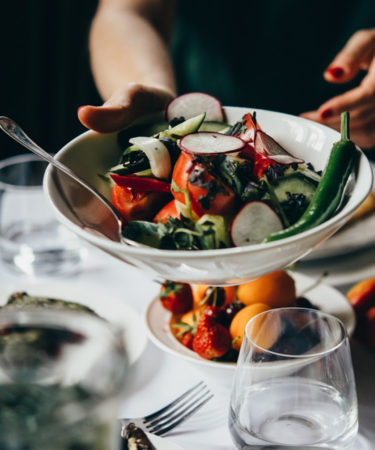Is any wine descriptor more taboo than the term “sweet”? Despite the fact that we guzzle soda and will spend $15 for a milkshake with an actual slice of cake in it, Americans stave off sweet wines like they’re the devil. But if there’s any occasion to drink sweet wines, some of which are among the world’s most complex and long-lived vino, it’s sugar-filled Valentine’s Day.
The general rule of thumb is that sweet wines should always be paired with sweet food (hence the term “dessert wines”) and that the wine should always be sweeter than the dish. But there’s something to be said for the combination of sweet and savory. Do you dare to pair a sweet wine with the main course, rather than relegating it to the end of the meal? A few simple guidelines can lead to an adventurous and show-stopping pairing.
Follow these eight simple rules for out-of-this-world sweet and savory pairings, which will have you experimenting long past February 14.
Compare or contrast
There are two overarching philosophies when it comes to pairing food and wine: either compare the flavors, matching notes in the food and wine, or contrast them, using the wine to add flavors and aromas that the dish is missing. That’s why Sauternes, which typically tastes of orange marmalade and honey, pairs beautifully with duck a l’orange, matching the juicy citrus, as well as with intensely savory blue cheese. If, on the other hand, your dish has dark, rich flavors or distinct berry notes — think slow-roasted pork with cranberry sauce — Ruby Port is a natural pairing, sharing many of those flavors.
Acidity matters
Not all sweet wines are created alike, which is why Manischewitz and Liebfraumilch don’t really sit in the same category as Madeira and Tokaji. Balance is one of the key factors of a great sweet wine, and in order to have balance, a sweet wine needs good acidity. That acidity will also help balance a sweet wine pairing, cutting through the richness of certain dishes and standing up to the tartness of others. That’s why fatty foie gras is a classic (and expensive) Sauternes pairing, or why off-dry Riesling could actually work well with a salad dressed in sharp vinaigrette.
Match the body
For a pairing to work well, the body of both the food and wine should be comparable. A rich, sweet wine would overpower a light dish, and vice versa. Unctuous Tokaji is great with rich foie gras, since neither the food nor the wine will fall by the wayside. Do you dare to pair sweet wine with fish? Make sure it’s a lighter sweet wine, like Moscato d’Asti, in light of the dish’s delicacy.
Sweeter sauces love sweet wines
Savory foods don’t necessarily have to be entirely savory. Dishes with fruit reductions, sweet sauces, or honey glazes are excellent matches for sweet wines. If you’re worried that sweet on sweet will be too much of a good thing, don’t fret; sugar in food naturally diminishes the perception of sugar in wine, so a dry wine might actually be too harsh and acidic for dishes with sweet components. The sweet wine paired will actually seem drier than it does on its own, diminishing rich fruit and highlighting complex, non-fruit flavors.
Sugar and spice and everything nice
Alcohol only fans the flames of spicy food, so what’s the secret to pairing wine with tongue-numbing dishes? Sugar. Stick with lower-alcohol sweet wines, like Kabinett or Spätlese Riesling, to contrast intense spice and cool down the palate of even the spiciest dishes.
Season the food well
The sugar in sweet wines amps up the intensity of the flavors, so make sure that the food is flavorful and well-seasoned. Otherwise, the dish will just fade into the background.
Salt is a sweet wine’s best friend
Do you swoon for chocolate-covered pretzels or maple-glazed bacon? Then you’ve already experienced the explosion of happiness that occurs when sweet and salty unite. Potato chips, pretzels, and French fries all make tasty, indulgent pairings for sweet wines. Bonus points if you opt for jalapeño peppers with a sweet white, salty and spicy both screaming for sweet wine. Feeling a little more daring? Try edamame with sea salt paired with a light, acid-driven, off-dry white, or experiment by pairing salt-crusted prime rib with a sweet, structured red like Banyuls.
Don’t be afraid of age
Sweet wines can be some of the most age-worthy options around, bolstered and preserved by bountiful sugar. As wines age, they typically gain tertiary flavors like mushroom, nuts, and forest floor, which can integrate a sweet wine into a savory pairing more naturally. That’s what allows an old white Pineau des Charentes to pair beautifully even with a light, raw oyster dish, for instance.
